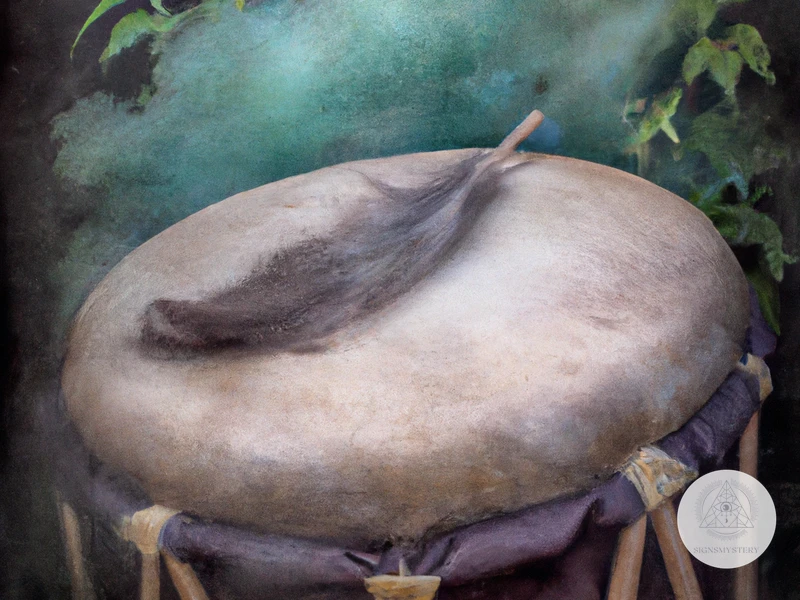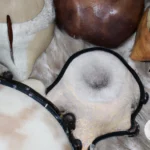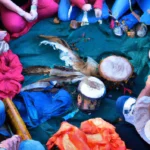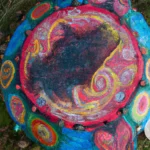When we think of shamanism, one of the first things that come to mind is the shamanic drum. This powerful tool has a long and rich history, dating back to ancient times. What makes the shamanic drum so significant? Why has it been a staple in shamanic practices for centuries? Join us on a journey of exploration and discovery as we delve into the history and meaning of the shamanic drum. From its origins in ancient cultures to its relevance in modern times, we’ll explore everything you need to know about this remarkable instrument of the spirit world.
The History of the Shamanic Drum
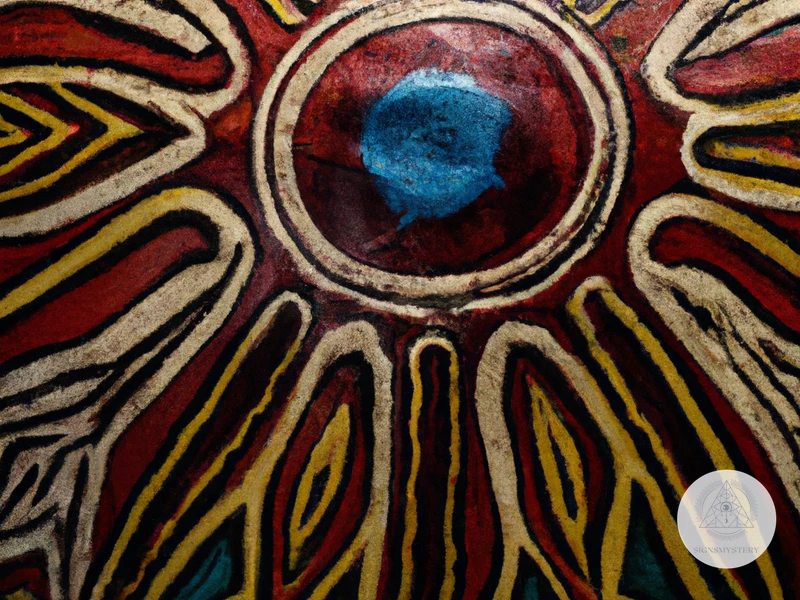
Shamanic drumming has a long history dating back centuries. Made from various materials like animal skins, wood, and stones, the shamanic drum has been an integral tool in many cultures, used for healing, divination, and spiritual communication. The Origins of Shamanic Drumming can be traced back to Siberia, where it was used in shamanic practices among the indigenous people. As shamanic practices spread throughout other cultures, so did the use of the drum. The Evolution of the Shamanic Drum varied across different cultures and regions. For example, in Africa, the djembe drum was used for spiritual and social purposes, while in the Americas, the Native American frame drum was used for healing ceremonies. Today, there are many types of shamanic drums used in different shamanic traditions around the world, each with its own unique sound and significance.
The Origins of Shamanic Drumming
The Origins of Shamanic Drumming can be traced back to ancient times, with evidence of its use found in various cultures around the world. One of the earliest known examples is a pottery vessel found in Peru which depicts a shamanic figure holding a drum. Here are some other examples of the early use of shamanic drumming:
| Culture | Timeframe | Details |
|---|---|---|
| Siberian | Unknown | The shamanic drum was made from a single piece of wood and was considered to be a sacred object, often decorated with images of animals or the shamanic journey. |
| Native American | Unknown | The drum was often made from buffalo hides and the sound was believed to represent the heartbeat of Mother Earth. |
| African | Unknown | The drum was used in healing and ceremonial contexts, with various rhythms and sounds believed to have different effects. |
While the exact origins of shamanic drumming are unknown, it is believed that the practice emerged as a way to connect with the spirit world and enter altered states of consciousness. The repetitive beat of the drum is thought to induce a trance-like state, allowing the shaman to journey to other realms and communicate with spirits. Additionally, the drum was believed to have protective qualities, helping to ward off negative energies or entities during shamanic journeys.
Today, shamanic drumming is still widely practiced, both in traditional contexts and in modern adaptations. Many people are even choosing to make their own shamanic drums as a tool for their own healing and spiritual practice. To learn more about this process, check out our article on how to make a shamanic drum.
The Evolution of the Shamanic Drum
As shamanic cultures evolved around the world, so did the use and design of the shamanic drum. Different tribes, regions, and historical periods developed unique drumming techniques, materials, and motifs that provided powerful spiritual and communal experiences for their communities.
For example, the Siberian shamanic tradition developed a large drum made of reindeer skin, which was often decorated with images of animals and cosmic symbols. In contrast, the Native American tradition of the Great Plains used smaller drums made of stretched hides, with intricate beadwork and feather attachments.
The African shamanic tradition of the Bantu people emphasized the collective nature of the drumming experience. They used large drums that required several players to create the complex rhythms that brought people into trance. In other regions of Africa, such as the Congo, the Babongo people used drums that were played only by the shaman and served as a conduit to the spirit world.
As shamanic practices continued to spread and evolve, the shamanic drum also found its way into religious and secular contexts. In some cases, the shamanic drum became an integral part of Christian church services, as seen in the African-American tradition of gospel music.
The evolution of the shamanic drum is a testament to the ingenuity and adaptability of human culture. Today, the shamanic drum continues to serve as a powerful tool for spiritual healing and transformation in modern shamanic practices and sound therapy.
The Significance of the Shamanic Drum
The Shamanic Drum has great significance in shamanic practices as it serves as a tool for connecting with spiritual entities and the divine. The drumming creates a rhythmic vibration that induces altered states of consciousness, allowing the shaman to enter into a trance and travel outside of their body. The sound of the drum is believed to carry the shaman and their consciousness to other realms and dimensions where they can communicate with spirits and energies that can assist in healing and transformation. The power of the drumming extends beyond just spiritual connection, as it has been proven to have physical effects on the body’s nervous system and brainwaves. Some shamanic traditions even use specific drumming techniques and intentions to target certain areas of the body or emotions for healing. The Shamanic Drum is a versatile tool that continues to have significance in modern times and is utilized in activities such as sound healing, shamanic journeying, drumming circles, and more.
The Power of Rhythm and Sound
The power of rhythm and sound is at the core of shamanic drumming. The drumbeat acts as a bridge between the physical and spiritual realms, allowing the shaman to enter altered states of consciousness and connect with spirits and ancestors. The rhythmic beats of the drum have a profound effect on the brain and body, inducing trance states and allowing the shaman to move beyond ordinary reality.
Studies have shown that drumming can lower stress levels and promote relaxation. The repetitive beat of the drum is believed to synchronize brainwaves, inducing alpha and theta states associated with calmness, creativity, and spiritual awareness. The shamanic drumming techniques have been used for centuries to facilitate healing, transformation, and spiritual development.
Through the power of intention, shamans can use the drumbeat to direct their energy towards a specific goal. Intentional drumming can be used to create a sacred space, invoke spirits, or send healing energy to an individual or group. The shamanic drumming circles are often used as a form of group therapy, where participants can share their experiences and support each other’s healing journeys.
The power of the shamanic drum extends beyond the individual and has a profound impact on the community. The drumming circles have been used for centuries as a way to bring people together, connect with their heritage, and celebrate life’s milestones. The drumbeat is believed to be a unifying force, bringing people from all walks of life together in a shared experience.
The power of rhythm and sound is integral to the shamanic drum. The drumbeat acts as a bridge between the physical and spiritual realms, inducing trance states and allowing the shaman to connect with spirits and ancestors. Whether used for healing, transformation, or community building, the shamanic drum remains a powerful tool for spiritual growth and self-discovery. For more information on the power of shamanic drumming, check out our article on shamanic drumming and brainwaves.
Connecting with Spirits and the Divine
One of the primary uses of the shamanic drum is for spiritual purposes, specifically for connecting with spirits and the divine. The repetitive beat of the drum can induce trance states and altered consciousness that can facilitate communication with the spiritual realm.
In shamanic traditions, the drum is often used as a tool for journeying, where the shaman or practitioner enters into a trance state and travels to other worlds or dimensions to connect with spirits or receive guidance. The drumming provides a steady and consistent rhythm that helps the shaman to maintain their altered state and navigate the spiritual realms.
The shamanic drum is also used in rituals and ceremonies to honor and connect with various deities and spirits. In some traditions, each beat of the drum is believed to call upon a specific spirit or energy and the shaman may use different drumming patterns to communicate different messages or intentions.
It is believed that the sound of the drum can awaken dormant spiritual energies within the body and stimulate the chakras, or energy centers, leading to spiritual healing and transformation.
The shamanic drum is a powerful tool for those seeking to connect with the spiritual realm and discover their inner selves. If you’re interested in learning more about the spiritual benefits and techniques of shamanic drumming, check out our article on drumming in shamanic journeying or join a drumming circle that incorporates shamanic practices.
Healing and Transformation
One of the most significant uses of shamanic drumming is for healing and transformation. The drum is believed to have the power to heal not only physical diseases but also mental and emotional afflictions. The shamanic drumming technique helps to induce a state of trance and helps the shaman or the person playing the drum to connect with their inner self.
The shamanic drum is often used in sound healing therapy. The powerful sound of the drum can help to shift energy and release emotional blockages, allowing the person to heal on a deeper level. The energy of the drum also helps to balance the chakras and restore the body’s natural rhythm.
Shamans have used the drum to heal individuals and entire communities for centuries. The shamanic drumming session may involve chanting, singing, and other rituals that help the person to connect with their spiritual guides. Many people who have undergone shamanic drumming therapy report feeling a profound sense of clarity, insight, and inner peace.
The shamanic drum is also used in transformational rituals. By inducing a trance state, the drum helps a person to access their subconscious mind and explore their deepest fears, desires,
Subscribe to Our Newsletter
Sign up to receive the latest news and updates.
In modern times, shamanic drumming has gained popularity as a form of alternative therapy. Its powerful effects on the nervous system have been studied extensively, and it has been shown to reduce stress, anxiety, and depression. It is also effective in treating addiction and post-traumatic stress disorder.
The healing and transformational power of the shamanic drum is truly remarkable. It is a sacred instrument that has been passed down from generation to generation and continues to provide immense value in our modern world.
The Shamanic Drum in Modern Times
In modern times, the Shamanic Drum continues to be an important tool for spiritual and healing practices. While some adaptations and innovations have been made, the basic design and purpose remain the same. Some practitioners have explored sound healing with shamanic drums and developed new techniques to enhance their drumming experience. There is also an emphasis on setting specific intentions and using the drumming as a way to connect with the nervous system for stress reduction and other health benefits. However, it is important to preserve the cultural heritage and respect the traditional uses of the Shamanic Drum passed down through generations.
Adaptations and Innovations
The shamanic drum has undergone various adaptations and innovations in modern times. One such adaptation is the development of the synthetic drum, which is made of synthetic materials instead of animal hides. While some purists may argue that these synthetic drums lack the authenticity and spiritual power of traditional drums, they have gained popularity due to their consistency and durability.
In addition to synthetic materials, modern technology has also been used to create innovative variations of the shamanic drum. One such example is the electric drum, which adds a new dimension to shamanic drumming with its electronic sounds and effects.
Contemporary shamanic practitioners have developed new methods of playing the shamanic drum, incorporating diverse rhythms and techniques to enhance communication with the spirit world. These innovative approaches have resulted in a wider range of shamanic drumming styles, each with its unique characteristics.
It should be noted that these adaptations and innovations have not replaced traditional shamanic drumming practices, but rather have expanded the possibilities for personal expression and spiritual exploration. While the original use and purpose of the shamanic drum remain unchanged, modern adaptations and innovations have added depth and diversity to this ancient practice.
The Preservation of Cultural Heritage
The preservation of cultural heritage is a significant aspect of shamanic drumming. Shamanic traditions and their associated practices have been passed down from generation to generation as treasured cultural heritage. As such, the shamanic drum holds deep cultural, spiritual, and historical significance. Since the shamanic drum is a significant symbol of cultural heritage, its preservation is critical to the survival of these traditions.
Preservation of Traditional Drumming Techniques: In many communities around the world, traditional shamanic drumming practices are under threat from modernization and globalization. It is essential to preserve these ancient drumming techniques and practices. In many indigenous communities, this is done through the passing down of knowledge from the elders to the younger generations. Also, several organizations are working to preserve shamanic drumming practices by offering workshops, classes, and collaborations with indigenous communities.
Protection of Endangered Species: Shamanic drums are typically made from animal hides and other natural materials, which means its creation directly impacts wildlife. In various communities, the use of animal skins is a crucial aspect of cultural heritage, and it is necessary to preserve this important part of the shamanic tradition. However, it is essential to ensure that these natural materials are ethically sourced without putting endangered species at risk. Some organizations work to create partnerships with local communities to source alternative materials and develop sustainable practices.
Revitalization of Sacred Sites: Shamanic practices are often associated with sacred sites, which are significant for their cultural and spiritual heritage. However, many of these sacred sites are under threat from development, pollution, and other environmental factors. To preserve these cultural heritage sites, it is crucial to create awareness of their significance; some organizations focus on educating people on the importance of these sites and the need to protect them.
The preservation of cultural heritage is a crucial aspect of shamanic drumming, and it involves protecting traditional drumming techniques, ethical sourcing of natural materials, and conservation of sacred sites. With the help of education, awareness, and collaboration, we can ensure that shamanic drumming practices and cultural heritage will remain for generations to come.
Conclusion
In conclusion, the shamanic drum has a rich history and continues to hold great significance in many cultures around the world. From its origins in ancient shamanic practices to its modern-day adaptations and innovations, the drum remains a powerful tool for connecting with the spiritual realm, promoting healing and transformation, and preserving cultural heritage.
Through the power of rhythm and sound, the shamanic drum can awaken deep spiritual awareness in individuals and communities. It provides a means of communication with the divine and can be used to facilitate deep inner journeys of discovery and healing.
Despite cultural appropriation and commercialization of this sacred tool, it is crucial that efforts are made to preserve its true essence and use. Moreover, it is important for non-indigenous individuals to learn about the cultural and spiritual significance of the shamanic drum and respect its heritage.
The shamanic drum has and will continue to play a crucial role in the spiritual and healing practices of many communities around the world. It is a reminder of our deep connection to nature, spirit, and each other, and the power we hold within us to create positive change in our lives and the world around us.
Frequently Asked Questions
What is a Shamanic Drum?
A Shamanic Drum is a tool used in shamanic traditions for various purposes, such as healing, communication with spirits, and journeying.
What is the history of the Shamanic Drum?
The Shamanic Drum has been used for thousands of years, with its earliest origins being traced back to ancient Siberia.
How is the Shamanic Drum traditionally made?
The Shamanic Drum is traditionally made using a wooden frame and animal hides, such as reindeer or goat, for the drumhead.
What is the significance of the Shamanic Drum?
The Shamanic Drum is believed to have a sacred and powerful energy that can be used for healing, connecting with spirits, and transformation.
How is the Shamanic Drum used for healing?
The Shamanic Drum is used for healing through sound therapy, where the rhythmic beats of the drum can induce a state of relaxation and promote physical, emotional, and spiritual healing.
What is journeying in shamanic traditions?
Journeying is a shamanic practice where one enters a trance state using techniques such as drumming, and travels to the spiritual realms to connect with spirits and gain guidance.
How does the Shamanic Drum connect with spirits and the divine?
The Shamanic Drum is believed to have a direct link to the spiritual realms, and through its rhythmic beats, can open a doorway for communication with spirits and the divine.
What adaptations and innovations have been made with the Shamanic Drum in modern times?
In modern times, the Shamanic Drum has been adapted for different cultural practices and has been combined with other healing modalities, such as Reiki and meditation, for a more holistic approach.
What is the importance of preserving cultural heritage with the Shamanic Drum?
The Shamanic Drum is an important part of cultural heritage for many indigenous communities, and preserving these traditions is vital for preserving cultural diversity and promoting respect for different ways of life.
Can anyone use a Shamanic Drum?
While anyone can use a Shamanic Drum, it is important to approach the practice with respect and understanding of its cultural significance and traditional use.

